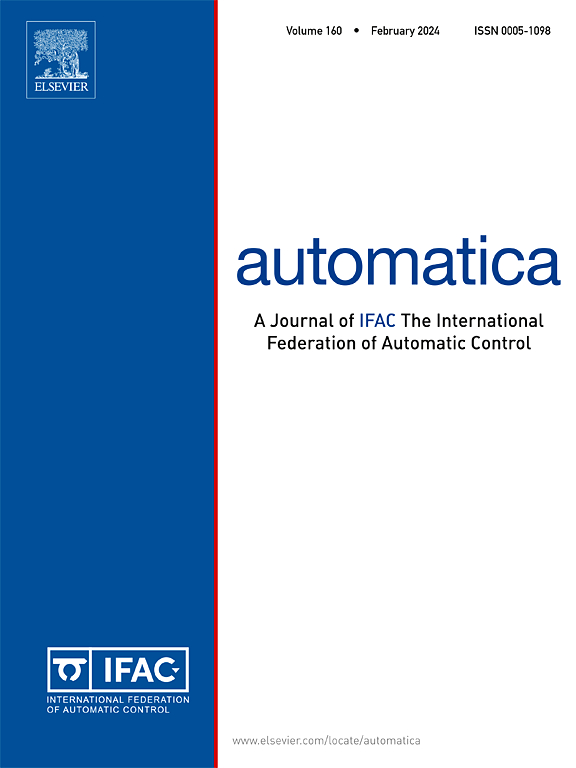非光滑动力系统中测度的演化:形式和计算
IF 5.9
2区 计算机科学
Q1 AUTOMATION & CONTROL SYSTEMS
引用次数: 0
摘要
本文发展了用连续性方程研究非光滑动力系统测度演化的数学形式,并提供了数值方法。用演化变分不等式来描述非光滑动力系统,并利用三种不同的形式导出了与这类系统相关的连续性方程。第一种形式是利用叠加原理来描述一个测度的连续性方程,该测度分解为一个由向量场集合支持的概率测度和另一个表示系统轨迹在每个时刻分布的测度。第二种形式是基于非光滑向量场的正则化,并将测度描述为与正则化参数相关的一系列测度的极限。在此过程中,我们得到了正则化向量场的测度解与非光滑向量场的极限测度之间的Wasserstein度量的定量界。第三种形式使用时间步进算法来模拟测量的时间离散演化,并表明随着采样时间趋近于零,与连续性方程相关的绝对连续轨迹在极限中恢复。我们还用数值例子验证了每种形式。对于第一种形式,我们使用多项式优化技术和矩- sos层次来获得测度的近似矩。对于第二种形式,我们用一个可以计算Wasserstein度规的封闭形式表达式的学术例子说明了Wasserstein度规的边界。对于第三种形式,我们通过一个例子说明了基于时间步进的度量进化算法,该算法显示了度量集中的影响。本文章由计算机程序翻译,如有差异,请以英文原文为准。
Evolution of measures in nonsmooth dynamical systems: Formalisms and computation
This article develops mathematical formalisms and provides numerical methods for studying the evolution of measures in nonsmooth dynamical systems using the continuity equation. The nonsmooth dynamical system is described by an evolution variational inequality and we derive the continuity equation associated with this system class using three different formalisms. The first formalism consists of using the superposition principle to describe the continuity equation for a measure that disintegrates into a probability measure supported on the set of vector fields and another measure representing the distribution of system trajectories at each time instant. The second formalism is based on the regularization of the nonsmooth vector field and describing the measure as the limit of a sequence of measures associated with the regularization parameter. In doing so, we obtain quantitative bounds on the Wasserstein metric between measure solutions of the regularized vector field and the limiting measure associated with the nonsmooth vector field. The third formalism uses a time-stepping algorithm to model a time-discretized evolution of the measures and show that the absolutely continuous trajectories associated with the continuity equation are recovered in the limit as the sampling time goes to zero. We also validate each formalism with numerical examples. For the first formalism, we use polynomial optimization techniques and the moment-SOS hierarchy to obtain approximate moments of the measures. For the second formalism, we illustrate the bounds on the Wasserstein metric for an academic example for which the closed-form expression of the Wasserstein metric can be calculated. For the third formalism, we illustrate the time-stepping based algorithm for measure evolution on an example that shows the effect of the concentration of measures.
求助全文
通过发布文献求助,成功后即可免费获取论文全文。
去求助
来源期刊

Automatica
工程技术-工程:电子与电气
CiteScore
10.70
自引率
7.80%
发文量
617
审稿时长
5 months
期刊介绍:
Automatica is a leading archival publication in the field of systems and control. The field encompasses today a broad set of areas and topics, and is thriving not only within itself but also in terms of its impact on other fields, such as communications, computers, biology, energy and economics. Since its inception in 1963, Automatica has kept abreast with the evolution of the field over the years, and has emerged as a leading publication driving the trends in the field.
After being founded in 1963, Automatica became a journal of the International Federation of Automatic Control (IFAC) in 1969. It features a characteristic blend of theoretical and applied papers of archival, lasting value, reporting cutting edge research results by authors across the globe. It features articles in distinct categories, including regular, brief and survey papers, technical communiqués, correspondence items, as well as reviews on published books of interest to the readership. It occasionally publishes special issues on emerging new topics or established mature topics of interest to a broad audience.
Automatica solicits original high-quality contributions in all the categories listed above, and in all areas of systems and control interpreted in a broad sense and evolving constantly. They may be submitted directly to a subject editor or to the Editor-in-Chief if not sure about the subject area. Editorial procedures in place assure careful, fair, and prompt handling of all submitted articles. Accepted papers appear in the journal in the shortest time feasible given production time constraints.
 求助内容:
求助内容: 应助结果提醒方式:
应助结果提醒方式:


